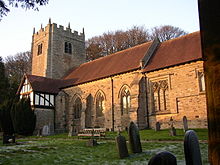Halton-on-Lune
Coordinates: 54 ° 5 ′ N , 2 ° 46 ′ W
Halton or Halton-on-Lune is a place in Lancashire , England . Together with the hamlet of Aughton , it forms the civil parish Halton-with-Aughton . The civil parish has 2306 inhabitants (2001).
Halton is mentioned as Haltun in the Domesday Book , but it also had meaning before that, as it belonged to Earl Tostig, brother Harald II . After the death of Earl Tostig and the Norman conquest of England , the importance of the place changed. Lancaster , 5 km to the west, was a major attraction for the nobility as a place of residence. Nevertheless, the strategic importance of the place directly on the River Lune was retained. In Halton are the remains of a fortress from the 12th century. The fortification was built on an artificially created hill, a moth , the base of which today has a diameter of 95 m and a height of 3.20 m, the surface of the castle hill has a diameter of 11 m. An observation post was set up on the plateau in 1939 and a flagpole was later erected, which further destroyed the heavily damaged hill. The castle is one of several castles in the River Lune valley that no longer exist, but which once served as an important line of defense against enemy incursions from the north into England, across the Shap Summit pass and then along the course of the River Lune could be carried out at Tebay , protected and still today demonstrate the borderland character of this area after the Norman conquest. With the growing importance of Lancaster, however, the importance of the fortress in Halton dwindled and the complex was finally given up.
The church of St Wilfrid's Halton has its origins in vornormannischer time. The current church building is from the 19th century and the church tower from the 16th century. The church is a Grade II protected monument. On the church grounds there is an Anglo-Saxon high cross made of sandstone that represents the Sigurd legend . The cross, which is one of fewer than 50 remaining crosses of this type in the north of England, is a scheduled monument.
Until 1966 the Halton station was operated on the former "Little" North Western Railway and then the Leeds – Morecambe line. Trains between Leeds and Morecambe now run on a different route and the old route has been converted into a bicycle and walking route.
See also
Individual evidence
- ↑ Ordnance Survey: Halton ( English ) Retrieved April 26, 2019.
- ↑ William Farrer. J. Brownbill (Ed.): A History of the County of Lancaster. Vol. 8, Constable, London 1914, pp. 118-126. The parish of Halton.
Web links
- Castle Hill, Halton Lancashire County Council.
- Church of St Wilfrid at English Heritage
- Highcross at St Wilfrid's Churchyard, Halton at English Heritage.
